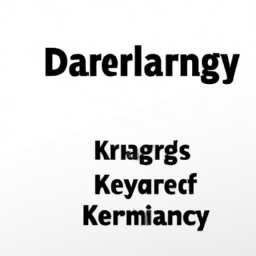Understanding Keyword Difficulty Range for Improved SEO Results
Table of Contents []
Keyword Difficulty Range
A Preface to the Journey Ahead
The internet is a vast and mystifying resource of information, ideas, products and servicesall which can be accessed within a simple click or tap. Understanding the digital landscape is now a necessity for any business endeavor to be successful. SEOand especially keywordsare a prime factor of this success. This article hopes to break down the keyword difficulty range, discuss some of the core concepts and offerings, and serve as a reminder of the vastness of the spectrumall with the help of simple and easily digestible parameters.
Main Exposition
Digging into the Different Keyword Ranges
When talking about keyword difficulty, it basically means how simple or hard it is to rank for a summarizing query. Generally-speaking, there are three common keyword difficulty ranges. Low-competition keywords have easier search volumes and their difficulty ranking is low. Medium-competition keywords have an average difficulty and slightly higher search volumes. High-competition keywords have higher search volumes and a higher difficulty.
Low-Competition Keywords
Low-competition keywords are keywords with low search volumes, a low cost of competition, and thus a low keyword difficulty ranking. These types of keywords are often found with niche topics and long-tail keywords. It is far easier for companies, large and small, to rank for their desired users when using low-competition keywordsand because of their higher specificity, they tend to be more effective at driving quality leads and conversions.
Medium-Competition Keywords
Medium-competition keywords have an average difficulty but still wit a relatively higher search volume than low-competition keywords. These keywords are often related to more popular topics and can still be easily ranked with the help of a strong search engine optimization and/or pay-per-click strategy. Because of their relatively higher search volume, they can act as a springboard to higher (or "high-competition") keywords and should not be considered overly risky investments.
High-Competition Keywords
High-competition keywords have higher search volumes, thus higher keyword difficulty rankings. These keywords are extremely competitive and take a strong and well thought-out SEO strategy to be successful. Cost-per-click of ads can be significantly higher and often take many tries to be successful. This does, however, come with the reward of being highly visible on search engine results pages and thus driving a high volume of leads and conversions.
Brief Recap
It is important to understand the keyword difficulty range and the implications and rewards of each. Low-competition keywords offer higher specificity and thus higher quality conversions while medium-competition keywords provide a risk-free option to increase visibility. High-competition keywords offer the ultimate reward of higher visibility and brand awareness but come with a higher risk from costs to competition. Using a well thought-out SEO strategy, however, companies can make educated and beneficial decisions as to which keywords best reflect their values and goals.
Looking Ahead
Whether you are SEO expert or a novice marketer, it is important to understand the different keyword difficulty ranges in order to help manage expectations, budgets, and portfolio metrics. Though this article may have introduced the concept, there are a wealth of resources and approaches available to learn more about keywords for effectiveness and longevity. Utilizing long-tail keywords with low competition can often be a game-changer so keep exploring and learning, and best of luck!
